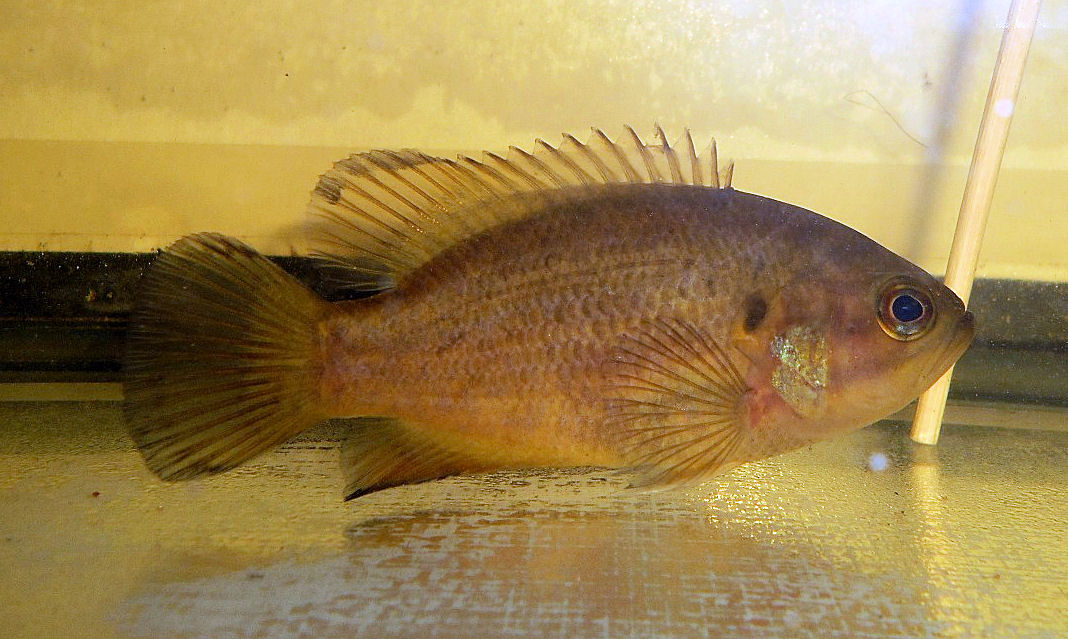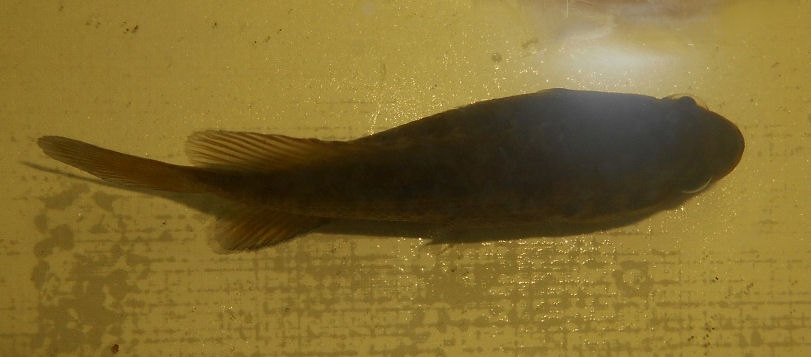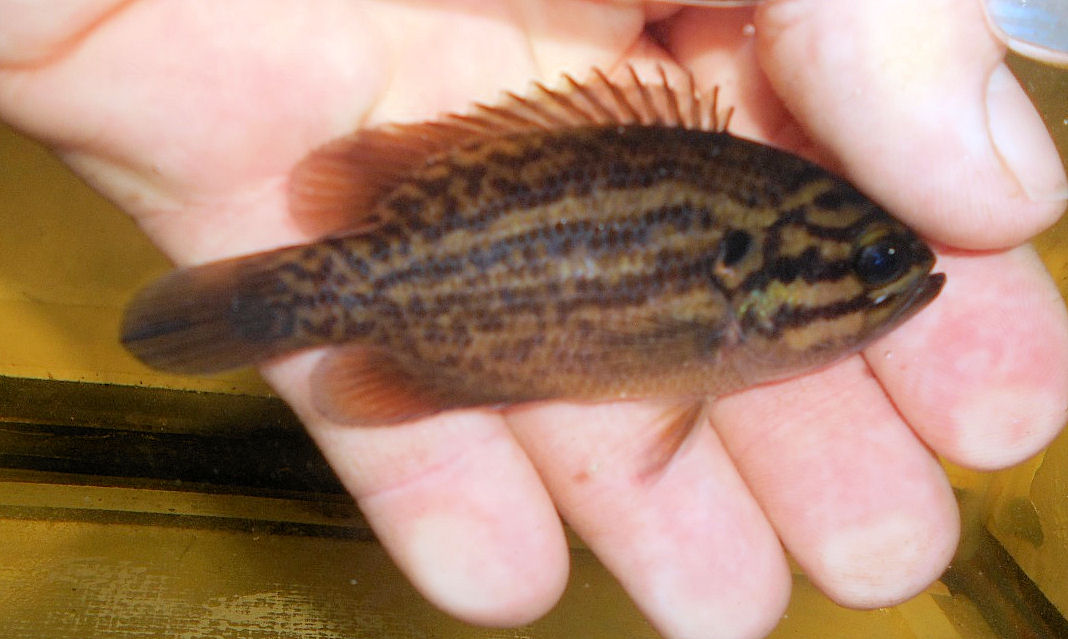Fish in Focus: Mud sunfish, Acantharchus pomotis

Acantharchus pomotis
Photo by Matt Knepley
Fish in Focus: Mud Sunfish, Acantharchus pomotis
(Updated from the original published in American Currents Spring 2018 by Matt Knepley)
“So by that rationale, if a pig had a better personality, he would cease to be a filthy animal? Is that true?”
“Well, we’d have to be talkin’ ‘bout one charmin’ [explicative] pig.”
Vincent and Jules in Pulp Fiction
In 1855, Spencer Fullerton Baird officially described one charmin’ water pig. Not brightly colored, elusive, and found of wallowing around in rather mucky habitats, the Mud Sunfish still manages to be one of the most popular aquatic pets of North American native fish enthusiasts. Indeed, from casual observation of chatter on the NANFA forum and other message boards, as best I can tell among sunfishes only Longears and Warmouths enjoy as much popularity. Having been lucky enough to have one of these creatures for a short time now, I can attest that personality does indeed go a long way! At first I tried to do this write-up in a more formal manner, but found my fish’s personality constantly butting its way into my thoughts and sentences. So you’ll have to excuse me because I’ve given up and will be writing this as if my fish is the only one…
First, some basic intel on our subject. He is an individual right from the start, belonging to a species that is the only member of its genus. His scientific name, Acantharchus pomotis, is a snazzy way of saying “Thorned-anus lid-ear”! Not particularly attractive as names go, but in this case it’s accurate. A Mud Sunfish has four to six solidly developed anal fin spines and lid (gill cover) where you’d expect an ear to be, if fishes had external ears.
Field identification of Mud Sunfish is easy. His build is obviously that of a sunfish, albeit just a little on the long side yet somehow chubby, too. He’s got a short head with big eyes that are very good at focusing forward. The mouth is huge for a sunfish, and when opened to its widest makes one think of a Largemouth Bass. He seems to like to show this feature off, too. Long, slow, exaggerated yawns are often on display. He likes to strut his stuff head-on to you, and the view down that cavernous mouth, into the throat and out the gills is indeed impressive for a fish that maxes out around six inches in length. His caudal peduncle, like the rest of him, is beefy.

The dorsal fin is long and low for a sunfish, with no gap or notch to speak of between the spiny and soft rayed portions. The caudal fin is rounded, and along with the well-spined anal fin may have a dark outer edge.
His scales are his most interesting physical feature, and the one that makes field identification a breeze. A Mud Sunfish is the only member of the sunfish family that has cycloid scales. Cycloid scales are scales that lack the tiny backward facing “teeth” that causes your finger to snag and skip if you lightly run your finger from a fish’s tail to its head. So he may be one beefy, big mouthed dude, but he’s still smooth.
Coloration is not flashy. Background coloration is an olive-tannish hue, There are three chocolate brown stripes on his head above his jaw that run halfway across his gill cover. The gill cover has a dark brown spot. Depending on the age and mood of the fish, it may or may not have dark patterning on its sides. Younger fish sometimes have no markings other than their face stripes and opercular spot. As they age they tend to develop parallel rows of horizontal chocolate brown spots. Later on these “spot rows” grow into three or four thicker but less defined rows. Many specimens sport some mottling. The darker patterns tend to be bolder in a stressed fish.
 The author’s Mud Sunfish’s coloration when happy. |  The same fish feeling stressed. |
To find Mr. and Mrs. Thornanus lidear in their natural habitat you will need to search the Atlantic Coastal Plain of the United States, from extreme southern New York, down to north Florida, and westward across southernmost Georgia and the Florida panhandle. It is known from one location in Alabama.
Preferred Acantharchus pomotis habitats are swamps, ponds, and sluggish streams. The bottom will likely be silt or mud, sometimes with a layer of decaying plant matter. Cover will be ample and consist of thick vegetation and wood. Some seem to like undercut banks. Although generally thought of as a resident of dark water with acidic pH values as low as 4, it can also be found in clear water and at a pH as high as 9. Mud Sunfish tend to be sedentary within small territories.
As for captive care, I cannot speak with any real authority as I have had my Mud Sunfish for only a couple months now. But I am happy to share my experiences and observations thus far. I acquired the fish from Grand Bay Wildlife Management Area near Valdosta, GA. It was early February, overcast and exceptionally cold for South Georgia. Still, “Meat”, as he has come to be called, was in inches deep water among a thick layer of American Frogbit, Limnobium spongia. He was the only Mud Sunfish taken that day, though several Flier, Banded Sunfish and Bluespotted Sunfish were caught. Other cohabitants included Golden Topminnows, Gambusia, and loads of Pygmy Killifish. Oddly enough to me, no Pirate Perch were taken.
I have been pleased with Meat’s transition to captivity. He currently resides in a 20 gallon tall tank that he shares with two Bluespot Sunfish, and two Banded Sunfish that were also acquired on the same day in the same location. There haven’t been aggression issues yet but I’m prepared to re-home the Enneacanthus to an outdoor stock tank pond if things get chippy in the future.
The tank is filtered by a small hang-on-back power filter and a two-cartridge, air driven sponge filter. The substrate is a layer of silt and detritus 1–1.5” deep. There is no hardscape in the tank. Plant life is almost entirely floating and consists of collection site species; Frogbit, what appears to be an Utricularia of some type, and Duck Weed. (Lack of rooted plants may account for the fact that I have not seen Meat perform the headstanding resting behavior Mud Sunfish are famous for.) Twin 18” T-8 flourescents light the tank; but barely. The detritus keeps the water very, very brown.
As for feeding, it is no problem. He often attacks his live foods with what appears to be rage, almost as if he’s mad at his food just because it is his food! I recall one minnow that must’ve really agitated him. Not only did he absolutely hammer it, he vigorously chewed it up deep in his throat, and swam around his tank expelling a stream of fine, glittery scales out his gills! When he’s in this state, his body often gets a brighter shade of tan while his head becomes very dark. I haven’t gotten him to eat any prepared dry food or frozen “formulas”. Lists follow of what I have gotten him to eat, with favorites in bold. He also eats canned river shrimp sold for turtles
Live foods: Glassworms, Gambusia and Cyprinids, Eastern Grass Shrimp, Aquatic nymphs
Frozens: Bloodworms, Brine Shrimp, Mysis Shrimp, Plankton
Addendum
Since this FIF was published in American Currents, all of Meat’s tankmates had to be re-homed to an outside stock tank pond as he suddenly became very aggressive to them. Now that summer is here, his diet has grown to include many goodies found in the back yard. These include crickets, tiny grasshoppers, grubs, earthworms, army worms, and tadpoles. He loves earthworms, crickets, and grasshoppers. Grubs take a long time for him to eat, from the looks of things they are hard for him to chew. (He does seem to enjoy chewing his food!) The tadpoles are his least favorite. He will mouth flake, but always spits it out.
I also would like to take this chance to suggest the following sources which I have consulted regarding the natural history of Mud Sunfish;
References
American Aquarium Fishes, Robert J. Goldstein, Texas A & M University Press, College Station, 2000
Fishes of the Middle Savannah River Basin, Barton C. Marcy Jr., et al, The University of Georgia Press, Athens, 2005
Freshwater Fishes of South Carolina, Fred C. Rodhe et al, The University of South Carolina Press, Columbia, 2009
Geographic Variation of the Mud Sunfish, Acantharchus pomotis (Family Centrarchidae)
Robert C. Cashner, Brooks M. Burr and James S. Rogers
Copeia Vol. 1989, No. 1 (Feb. 27, 1989), pp. 129-141
Published by: American Society of Ichthyologists and Herpetologists (ASIH)
DOI: 10.2307/1445614
Stable URL: https://www.jstor.org/stable/1445614
Page Count: 13
Life History and Ecology of the Mud Sunfish (Acantharchus pomotis)
Garland B. Pardue
Copeia Vol. 1993, No. 2 (May 3, 1993), pp. 533-540
Published by: American Society of Ichthyologists and Herpetologists (ASIH)
DOI: 10.2307/1447156
Stable URL: https://www.jstor.org/stable/1447156
Page Count: 8
TWO MUD-LOVING FISHES. (An Aquarial Study of their Colour and Certain Habits.) By Dr. C. C. Arrott
Hardwicke’s Science - Gossip, 1875. pp 104 - 105
https://play.google.com/books/reader?id=G8MWAQAAIAAJ&pg=GBS.PA104